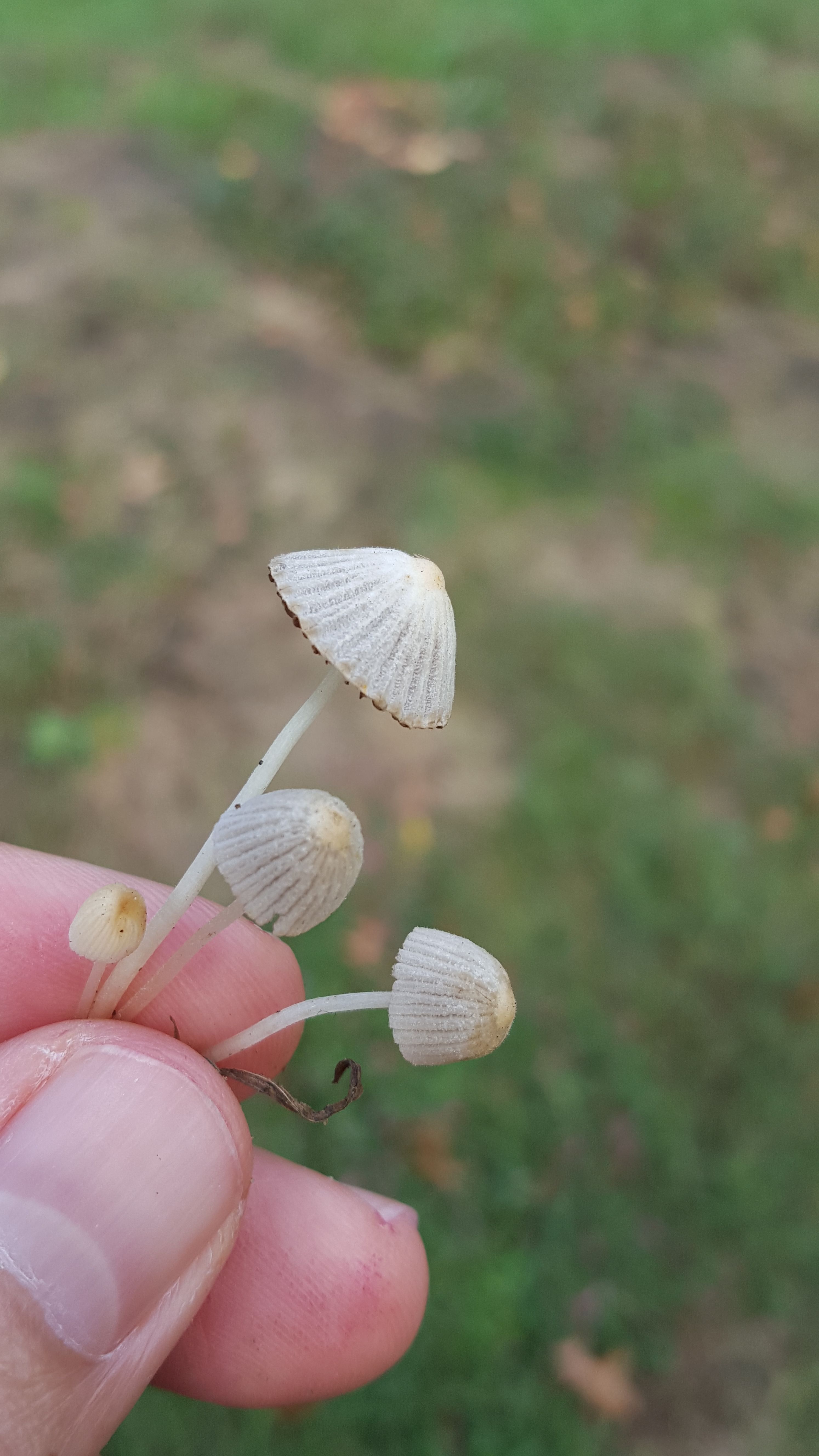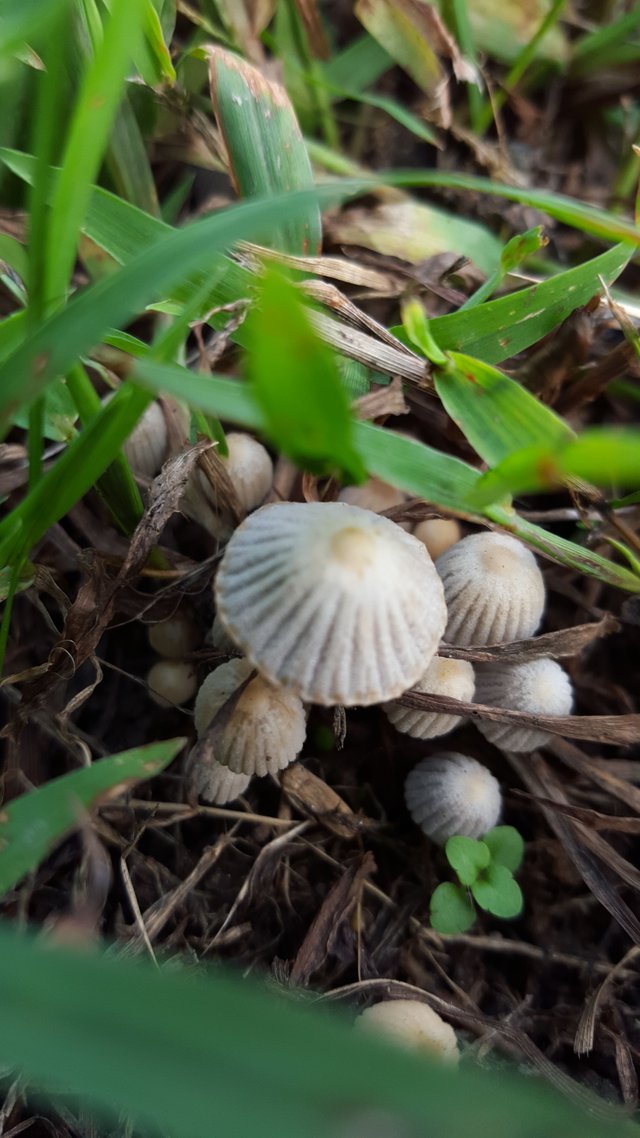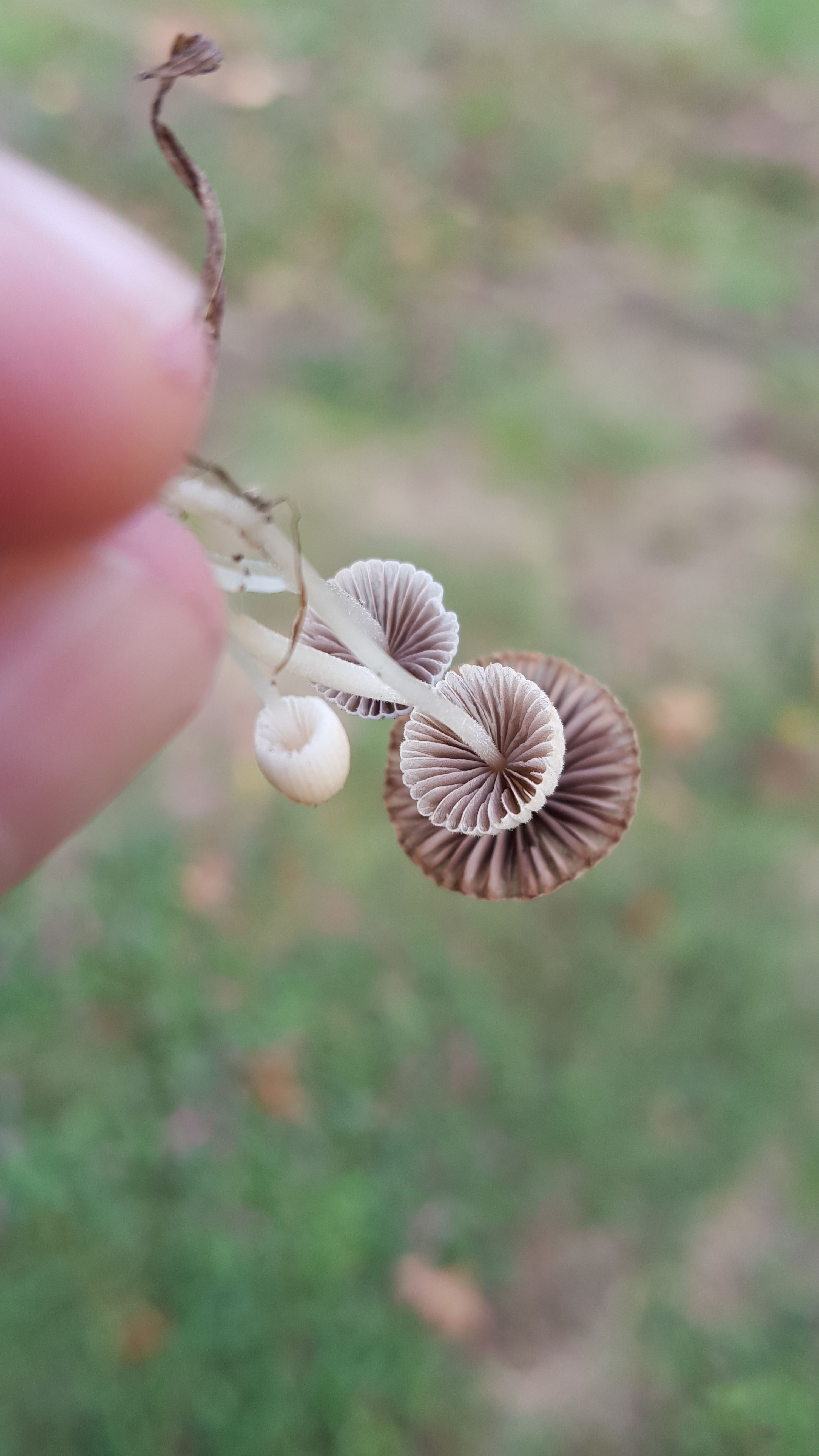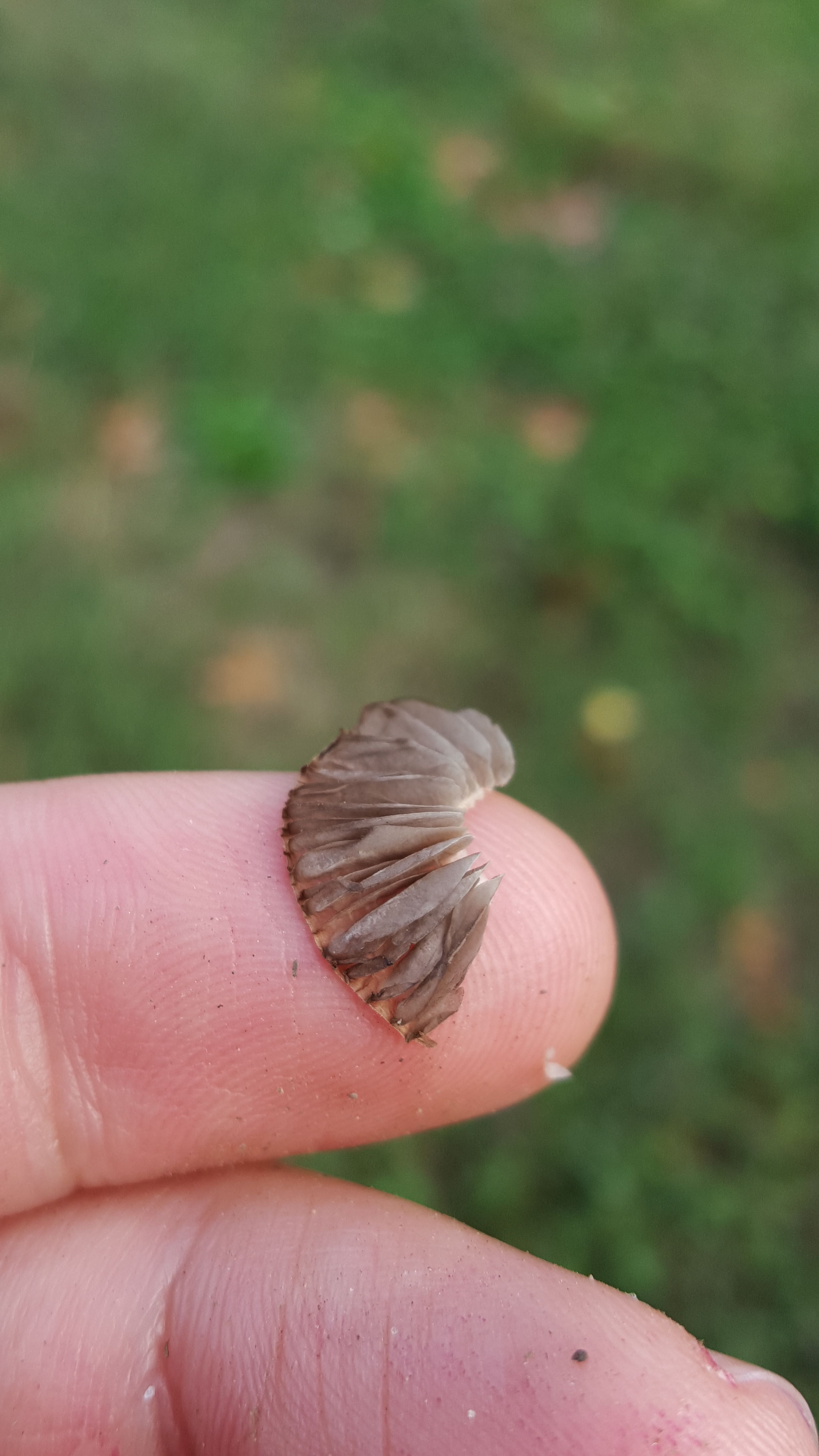The Amateur Mycologist - Random Find - Beautiful Coprinoid Species - Likely Coprinellus disseminatus
These posts are not for foraging. They are intended for entertainment and intellectual satisfaction only. These posts are not a field guide nor comprehensive in any way - their accuracy is not assured in any way. Do not eat wild mushrooms unless you are a professional, have substantial professional assistance or have a wealth of personal experience with a specific species. Do not make any foraging decisions based on these posts. To do so could be dangerous or life threatening.
These Posts Contains No Information Regarding Edibility Or Toxicity

Four individual mushroom caps, each representing a different state of maturity within the species
I found these delightful little fellows totally by chance, in a moment of unhappiness on what I felt had been a very unproductive walk through Central Park. There hadn't been rain for at least a couple of weeks, and all I seemed to encounter were the decomposing remains of old polypores, and cluster upon rotten cluster of some kind of Armillaria species.
I happened to see this small colony of Coprinoid mushrooms growing on a small, somewhat abnormal looking grassy hillock, just barely poking their heads above the ill-mown grass. If I didn't make it a habit -or should I say compulsion - to look squarely down wherever I walk, I would have walked right past these guys.
Instead, their small mushroom civilization caught my eye.

Another cluster of similar size grew nearby this one as well.
Finding Coprinoid mushrooms - generally the type of mushrooms that grow fast, mature faster, and then deliquesce into a black goo - tends to result in some very pretty pictures, if not a lack of concrete information.
It used to be that a great many "inky-cap" mushrooms were all clumped together in the Genus "Coprinus", which primarily included mushrooms based on the way they decomposed into an inky, goopy spore liquid. However, like so much in Mycology, genetics changed everything, and it turned out just because two species both deliquesce, does not mean that they can reproduce with each other.
Nowadays, the "inky-caps" fall into a larger cluster of genera - Primarily Coprinus, Coprinellus, Parasola, and Coprinopsis - while all of the mushrooms in these genera are loosely and unofficially referred to as "Coprinoid."
Considering the entire mycological community had the various coprinoid species confused for many decades, only to discover a wide-range of variation based primarily on DNA evidence, you can imagine that it might be difficult to identify a given Coprinoid species with any assurance based on macro-characteristics alone.
And you would be right - but you can make some educated guesses.

Here you can clearly see the progression of the gill color from young to roughly matured specimen.
First, lets break down what we know about these mushrooms. They are growing fairly gregariously, in two groups only a foot or so apart. At first glance, they appear to be growing out of the ground. However, further observation reveals a high likelyhood of thinly covered decomposing wood. How can we know this?
First, the grassy hill where they were looked strange from a landscaping perspective, as though there was a blank spot where a tree should have been.
Second, walking on the grass revealed an uneven surface, that had pockets of more or less give than normal grass, but did not appear to be newly sown.
Third, and most importantly, literally right next door to this colony of Coprinoid mushrooms grew two large Ganoderma florets. Mushrooms in the Ganoderma genus are fairly easy to place, and you'll remember that they grow saprobically, exclusively on dead or dying wood. Even though that Ganoderma looks like it is growing terrestrially, it must be growing on wood, which means the remnants of a tree or root system lay just under the grass on this hillock.

You can't see the Coprinellus mushrooms in this photo because they are quite small and hidden in the grass a couple of feet beyond the Ganodermas.
So, we can be pretty sure that these mushrooms are saprobic and growing on dead wood material. What else do we know:
They begin life with an almost ovular cap, that is nearly white, but with some browning near the top center. They expand in mid-life to become more convex, with a grayer color and clearly defined striations on the cap, but still retaining the light brown central spot. Finally, they become downright broadly convex or umbrella like.
If you zoom in to the caps and stems, at all points of maturity, you will see that they are covered in fine white hairs (fibrillose).
The stem is white, fibrillose, and hollow (not pictured).
The gills are unattached to the stem and, like the cap color, they go from white, to grey (maybe with a hint of lilac, although I don't entirely trust the color accuracy of this camera), to finally a darker gray. On the oldest specimen they seem to be blackening on the edges.
For this particular mushroom another macroscopic trait is also important to note, although I did so quite by accident.

These mushrooms were very easily broken
I picked up all four of the ones pictured above by their stems, and they held together nicely, but as soon as I began to poke at the oldest specimen, I accidentally broke it to pieces, as you can see above. This close up gives a better sense of the darkening gray color, as well as meeting the description Kuo provides, perhaps somewhat unhelpfully, of "close or almost distant."
And here we come to a problem of timing and transportation.
I wanted to bring home the four mushrooms I picked to see how they decompose - whether they leave a conventional spore print or deliquesce like many of their Coprinoid cousins. Obviously this question can be of great importance in discerning the identity of a given mushroom. Unfortunately, the mushroom's extreme fragility made transportation immensely difficult, and by the time I got home, even trying to be careful with them, the mushrooms had been broken and disfigured beyond usefulness.
As a result I was not able to determine whether the mushrooms deliquesce or leave a spore print and shrivel up.
Nonetheless, the battery of characteristics I did have lead me to believe that this mushroom was either a Parasola species or a Coprinellus species - specifically I ended up in a show down between Parasola plicatilis and Coprinellus disseminatus. Neither species deliquesces, and both look pretty damned similar - but in the end, it was the consistent fibrillose caps that convinced me. While P.plicatilis has faintly fibrillose stems, no description I found indicated fibrillose caps. Meanwhile, C.disseminatus is repeatedly quoted as having white hairs on the cap and stem, especially in the younger specimens.
This particular mushroom was found before I made my KOH solution, and before I bought my calibration slide for the microscope, so those additional indicia were not available.
THIS POST IS NOT INTENDED FOR FORAGING PURPOSES AND TO USE IT FOR THOSE PURPOSES WOULD BE DANGEROUS. DO NOT HUNT WILD MUSHROOMS WITHOUT RELYING ON A COMBINATION OF PROFESSIONAL FIELD GUIDES, IN PERSON PROFESSIONAL GUIDANCE, OR IN PERSON GUIDANCE BY SOMEONE TRUSTWORTHY WHO HAS COPIOUS LOCAL, SPECIALIZED MUSHROOM HUNTING EXPERIENCE. FAILURE TO DO SO CAN RESULT IN GRIEVOUS PERSONAL HARM OR DEATH.
Photos Are My Own
Information Sources:
[1]Kuo, M. (2008, February). Coprinellus disseminatus. Retrieved from the MushroomExpert.Com Web site
[2]First-Nature on C.disseminatus
[3]Mycoweb on Coprinellus disseminatus
[4]Kuo, M. (2011, February). Parasola plicatilis. Retrieved from the MushroomExpert.Com Web site
I found this one recently - is it a close relative of your Coprinoid mushroom?
Those are absolutely beautiful - and I've never seen anything like them. I think they may be totally unrelated in fact, they have very different characteristics, just at a glance - do y9u have more photos?
Wonderful post on mushrooms. Thank God you said it should not be eaten at the beginning of this post if not one could be tempted. They look beautiful especially the picture that shows the gill color of young and roughly matured mushroom. I really learnt from this.
Bravo! I love this post
I'm glad to hear that! I learn something new every post as well and try to make them as practically accessible as possible.
Ok...Good to know
I find a lot of those. It’s nice to know some more info on them. Nice Ganoderma in that shot.
There's a great deal to know about the various Coprinoid mushrooms - thia is really just a taste - as crazy as it seems, you could devote an entire sciebtific career to their study alone if you felt compelled to dive deep enough
Thank you for your informative articles! I learn so much!
Another great post @dber, so informative, you can feel your passion whilst reading this. Your photos are great once again, and they really put across how delicate these mushrooms are. Mushrooms are amazing, they play such an important part in keeping our planet alive,and yet they are so small and delicate that you could easily pass by them daily(as you pointed out in this post)without noticing them . Thanks again for sharing your passion with us.
Thanks for reading - it's true that this process has taken on an outsized importance as a hobby recently - it's been getting a lot of my attention - I'm glad you and others have been getting a kick out them.
I found a mushroom growing under some siding I was fixing last summer that looked somewhat similar. It was the weirdest thing.
That's not inconceivable, if the siding was untreated and there was a serious moisture problem. Generally any mushroom you find growing inside or on the materials of a structure imply a serious humidity issue.
Oh yeah it was a serious moisture issue. I do roofing repair and service work and this customer thought they had a roof leak but it was a siding leak so the OSB under the siding was getting wet and staying that way for long periods. I see fungus all the time but this was the first time there was a mushroom.